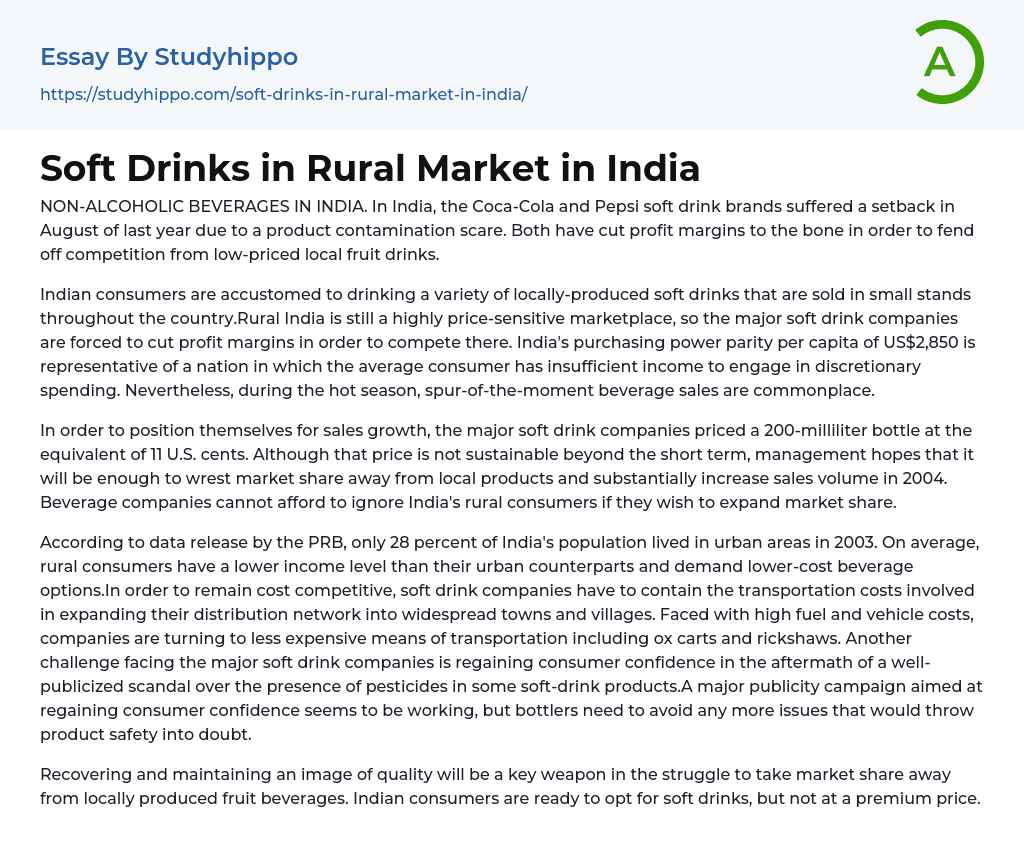NON-ALCOHOLIC BEVERAGES IN INDIA. In India, the Coca-Cola and Pepsi soft drink brands suffered a setback in August of last year due to a product contamination scare. Both have cut profit margins to the bone in order to fend off competition from low-priced local fruit drinks.
Indian consumers are accustomed to drinking a variety of locally-produced soft drinks that are sold in small stands throughout the country.Rural India is still a highly price-sensitive marketplace, so the major soft drink companies are forced to cut profit margins in order to compete there. India's purchasing power parity per capita of US$2,850 is representative of a nation in which the average consumer has insufficient income to engage in discretionary spending. Nevertheless, during the hot season, spur-of-the-moment beverage sales are commonplace.
In order to position themselves for sales growth, the
...major soft drink companies priced a 200-milliliter bottle at the equivalent of 11 U.S. cents. Although that price is not sustainable beyond the short term, management hopes that it will be enough to wrest market share away from local products and substantially increase sales volume in 2004. Beverage companies cannot afford to ignore India's rural consumers if they wish to expand market share.
According to data release by the PRB, only 28 percent of India's population lived in urban areas in 2003. On average, rural consumers have a lower income level than their urban counterparts and demand lower-cost beverage options.In order to remain cost competitive, soft drink companies have to contain the transportation costs involved in expanding their distribution network into widespread towns and villages. Faced with high fuel and vehicle costs, companies are turning to less expensive means
of transportation including ox carts and rickshaws. Another challenge facing the major soft drink companies is regaining consumer confidence in the aftermath of a well- publicized scandal over the presence of pesticides in some soft-drink products.A major publicity campaign aimed at regaining consumer confidence seems to be working, but bottlers need to avoid any more issues that would throw product safety into doubt.
Recovering and maintaining an image of quality will be a key weapon in the struggle to take market share away from locally produced fruit beverages. Indian consumers are ready to opt for soft drinks, but not at a premium price.
- Chief Executive Officer essays
- Convenience Store essays
- Firm essays
- Training And Development essays
- Unilever essays
- Variable Cost essays
- Virgin Group essays
- Bargaining essays
- Entity essays
- Pest analysis essays
- Advertising essays
- Audience Theory essays
- Competitor Analysis essays
- Consumer essays
- Marketing Management essays
- Marketing Mix essays
- Marketing Plan essays
- Marketing Research essays
- Marketing Strategy essays
- Point Of Sale essays
- Price essays
- Procurement essays
- Product essays
- Product Differentiation essays
- Promotion essays
- Promotion And Marketing Communications essays
- Retailing essays
- Trademark essays
- Anheuser-busch essays
- Brands essays
- Detergent essays
- Product Placement essays
- Research Design essays
- New Product Development essays
- Advertisement essays
- Brand essays
- Sales Promotion essays
- Advertising campaign essays
- Consumer behaviour essays
- Offer And Acceptance essays
- Wal-Mart essays
- Discover essays
- John Locke essays
- 9/11 essays
- A Good Teacher essays
- A Healthy Diet essays
- A Modest Proposal essays
- A&P essays
- Academic Achievement essays
- Achievement essays




